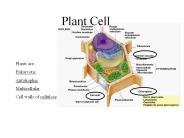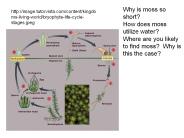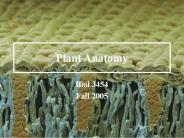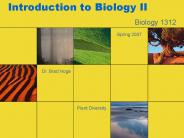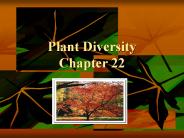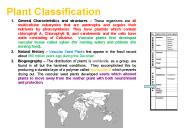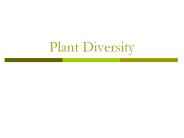Cycads PowerPoint PPT Presentations
All Time
Recommended
Scientific name: Cycas Found in the Jurassic period of the Mesozoic era. (250-145 million years ago) They can grow in Subtropical and Tropical climates.
| PowerPoint PPT presentation | free to view
Today, I visited the University of California Museum of Paleontology in Berkeley to learn about foss
| PowerPoint PPT presentation | free to download
Cycads resemble palms or tree-ferns in overall appearance but ... The #1 Site Dedicated to Teenage Bodybuilding! http://www.teenbodybuilding.com/gingko.htm ...
| PowerPoint PPT presentation | free to download
Cycads in South African park. Cycads are dioecious: this female plant has ovulate scales ... Cycad leaf leaflets unfurling like fern fronds (circinate vernation) ...
| PowerPoint PPT presentation | free to view
Division: Cycadophyta Cycads are vascular, seed plants that are palm-like and are called Sago Palms. The leaves are found in a cluster at the tops of the trunks.
| PowerPoint PPT presentation | free to download
... cycads, gnetophytes, and conifers Ginkgo Cycad Welwitschia Gnetum Ephedra Gymnosperms called gnetophytes; only 3 extant species Conifers: top row ...
| PowerPoint PPT presentation | free to download
Secondary stem- Smalls stems that grow from the main stem (tree branches) ... Ginkgophyta - Ginkgo. Cycadophyta - Cycads. Gnetophyta - Gnetum, Ephedra, Welwitschia ...
| PowerPoint PPT presentation | free to download
While ferns, cycads, ginkos occupy marginal niches today. In the mesozoic they dominated ... Les lentilles blondes du Puy. Apr s 15 jours, l'air. ...
| PowerPoint PPT presentation | free to download
Rise N' Shine Plant Nursery is biggest nursery for flowering plants like orchids, Adenium, Roses, Ixora, Trees avenues & Bamboos, Indoor & Outdoor Vertical garden plants, Climbers & Creepers, Lucky Bamboo, Fruit plants, Ferns, Palms & Cycads, Vegetables, Herbs, Spice, Medicinal plants, Foliage, Cacti & Succulents etc.
| PowerPoint PPT presentation | free to download
Kingdom Plantae - Plants Subkingdom Tracheobionta -- Vascular plants Superdivision Spermatophyta - Seed plants Division Cycadophyta - Cycads ...
| PowerPoint PPT presentation | free to view
The green algae called charophyceans are the closest ... Seeded Vascular Plants. Gymnosperms- conifers, cycads, and ginkgo. Angiosperms- flowering plants ...
| PowerPoint PPT presentation | free to view
Angiosperm origins and relationships of major lineages Vessels and tracheids Companion cells Pollen Fertilisation Development of Fruits Cycads Conifers Ginkgos ...
| PowerPoint PPT presentation | free to view
Papua New Guinea (485), Solomon (79), New Zealand (16) 602. Oceania ... It is not widespread but found now in New Guinea. Palms and Cycads. Cycad cone. Female ...
| PowerPoint PPT presentation | free to view
Plants are able to transform Water and Carbon ... Ginkgo. Conifers. Flowering plants. Daisies. Redwood tree. Onions. FERNS. CYCADS. ADAPTATIONS OF PLANTS ...
| PowerPoint PPT presentation | free to view
Some of the life forms were stromatolites, archea, ... Cockroach. Turtles. Bony Fish. Starfish. sharks. Plants. Cycads. Ginkgoes. Club mosses. Seed ferns ...
| PowerPoint PPT presentation | free to view
... among the three families and 12 living genera of cycads have been debated. ... the nuclear ITS/5.8S rDNA gene, to infer the cycad evolutionary relationships. ...
| PowerPoint PPT presentation | free to view
12: Gymnosperms and Angiosperms Gymnosperm: Non-flowering Angiosperms: Flowering plants GYMNOSPERMS Gymnosperm means naked seed Seeds lack a protective ...
| PowerPoint PPT presentation | free to download
Gymnosperm Lab Slides
| PowerPoint PPT presentation | free to download
Florida and Vermont in the US have some Unique Flower Garden Styles which have been mentioned in the presentation. To know more about such Flower gardens in the US visit myflowergardens.com
| PowerPoint PPT presentation | free to download
Fertilization happens in the megasporangium. Ovule/Seed= a megasporangium with an 'integument' ... spp.) Conifers _ cones. Dioecious or monoecious plants. Non ...
| PowerPoint PPT presentation | free to view
Title: PowerPoint Presentation Last modified by: SAM13633 Created Date: 1/1/1601 12:00:00 AM Document presentation format: On-screen Show (4:3) Other titles
| PowerPoint PPT presentation | free to download
Plant Anatomy Biol 3454 Fall 2005 Kingdom Planta 1-3 Divisions (Phyla) of Bryophytes 7-15 Divisions (Phyla) of Vascular Plants Divisions of Vascular Plants with ...
| PowerPoint PPT presentation | free to download
Seed Plants BSC 2011L Seed Vascular Plants Among plants, these include the gymnosperms and angiosperms Reproductive differences in seedless vs. seed plants Sporangia ...
| PowerPoint PPT presentation | free to download
... Welwitschia two huge leathery leaves Ephedra Mormon tree Gnetum leaves angiosperm-like vessels in the xylem considered an angiosperm characteristic have ...
| PowerPoint PPT presentation | free to download
Plants Starr/Taggart s Biology: The Unity and Diversity of Life Key Concepts: The plant kingdom consists mostly of multicelled photoautotrophs Almost all plants ...
| PowerPoint PPT presentation | free to view
Pinaceae Pinus Picea Larix Abies Tsuga Cupressaceae Thuja Juniperus Taxaceae Taxus Pinaceae Pinus Picea Larix Abies Tsuga Cupressaceae Thuja Juniperus Taxaceae Taxus ...
| PowerPoint PPT presentation | free to download
Seed Plants BSC 2011L Seed Vascular Plants Among plants, these include the gymnosperms and angiosperms Reproductive differences in seedless vs. seed plants Sporangia ...
| PowerPoint PPT presentation | free to download
Angiosperms. Adaptations to Land. Apical Meristems. Reproduction (Alternation of Generations) ... Plant. The Flower. Angiosperm Life Cycle. Pollination. Fruit ...
| PowerPoint PPT presentation | free to download
Botany Unit Notes Part II Seed Producing Plants Plants require water to photosynthesize sugars and make food Many plants even need water for reproduction!
| PowerPoint PPT presentation | free to download
LEC 01 Plant Evolution & Diversity Overview LOCAL FLORA Lecture 01 Dr. Donald P. Althoff SEEDS & FRUITS (not _____) ANGIOSPERMS Algae-to-Plants: Land Conquered ...
| PowerPoint PPT presentation | free to view
Gymnosperms and Angiosperms Gymnosperm Intro and evolution Life cycle and reproduction Uses and significance Angiosperms: Flowering plants Intro and evolution
| PowerPoint PPT presentation | free to view
Christmas trees' are usually conifers. A Pine life cycle is typical of conifers. . . The tree is the sporophyte generation and so forms spores ...
| PowerPoint PPT presentation | free to view
First cycad fossils from late ... Dioecious, both types of strobili large. Several features may be ancestral ... First unequivocal fossils date from Lower ...
| PowerPoint PPT presentation | free to view
Each pollen grain consists of four cells and a pair of wings which are used for dispersal. ... The anthers have fours chambers that produce quartets of pollen.
| PowerPoint PPT presentation | free to download
Today: What am I: Protistan Jeopardy! Plants, Part 1 Cool Coniferous Adaptations Minor Modifications Both gymnosperms and angiosperms use tracheids in their xylem.
| PowerPoint PPT presentation | free to view
Carboniferous origin. Sporophyte dominant. Fern life-cycle. homospory. Crozier or fiddlehead ... 2 types of sporangia means 2 types of spores. Generalized Life ...
| PowerPoint PPT presentation | free to view
Pines, firs, spruces, yews, junipers, cedars, cypress, and red woods. 550 species ... Cypress. Pine Farm. Phylum Anthophyta. Flowering Plants. Monocots and dicots ...
| PowerPoint PPT presentation | free to view
About 5% of all poisoning cases are caused by yard plants (not including mushrooms) Young children are most likely to be poisoned by these plants. A few Poisonous ...
| PowerPoint PPT presentation | free to view
12: Gymnosperms and Angiosperms Gymnosperm Intro and evolution Life cycle and reproduction Uses and significance Angiosperms: Flowering plants Intro and evolution
| PowerPoint PPT presentation | free to view
The Plant Kingdom: Gymnosperms Chapter 24 LEARNING OBJECTIVE 1 Compare the features of seeds with those of spores Discuss the adaptive advantages of plants that ...
| PowerPoint PPT presentation | free to view
Plant Diversity Chapter 22 What is a Plant? Plants are the base for the food chain on land. Provide shade, shelter and oxygen Evolved more than 470 million years ago ...
| PowerPoint PPT presentation | free to download
Distribution, separated by genus: Green Welwitschia Blue Gnetum Red Ephedra Purple Gnetum and Ephedra range overlap * Division: ...
| PowerPoint PPT presentation | free to download
Devonian plant community. Devonian plant community found at Rhynie, in Scotland. ... Photo courtesy of Scott Ridges. Tree ferns ...
| PowerPoint PPT presentation | free to download
Conifers are typical gymnosperms you see everyday. The oldest conifer living today is 4,900 years old. Conifers reproduce with cones. ...
| PowerPoint PPT presentation | free to view
Included Phyla: Cycadophyta, Ginkgophyta, Coniferophyta, ... Sporophytes: Dioecious; trees, shrubs with compound leaves and often only ... Dioecious; ...
| PowerPoint PPT presentation | free to view
An Evolutionary History of Plants. Life on Earth: The First Forests ... Flowers & Fruits appear. Seed Plants. Angio- sperms. Tracheophytes ...
| PowerPoint PPT presentation | free to download
Plants ... Plant Diversity
| PowerPoint PPT presentation | free to download
Modification to process: a ovule is formed that becomes the seed. ... slender branch, ovule plants to Carboniferous plants that look like tree ferns. ...
| PowerPoint PPT presentation | free to view
What is a Plant? with Plant Diversity Chapter 21 & 22 What is a plant? Multicellular eukaryote Produce their own food through photosynthesis Have thick cell walls ...
| PowerPoint PPT presentation | free to view
Cycad leaf leaflets unfurling like fern fronds (circinate vernation) Ginkgophyta. Ginkgo biloba ... What unusual feature (for gymnosperms) makes Ginkgo such a ...
| PowerPoint PPT presentation | free to view
Anthophyta (flowering plants) 'bryophytes' seedless. vascular (L.V.P.s) plants. seed plants ... Generalized Bryophyte Life Cycle. Phylum Hepatophyta - the liverworts ...
| PowerPoint PPT presentation | free to view
Iguanodons used their front legs to gather food. It had no real teeth, tons ... The Iguanodon lived in the Cretaceous period about 135-125 million years ago. ...
| PowerPoint PPT presentation | free to view
Early Jurassic Prosauropod - Massopondylus. Late Jurassic Sauropod - Apatosaurus ... Late Cretaceous Hadrosaur and Tyrannosaur- T. rex and Edmontosaurus ...
| PowerPoint PPT presentation | free to view
Title: Kingdom Plantae Author: Hazleton Area School District Last modified by: User Created Date: 1/4/2002 10:21:02 PM Document presentation format
| PowerPoint PPT presentation | free to download
Some defenses are constitutively present ... Cork cambium. Wound isolated from living part of plant body. Induced defenses - biochemical ...
| PowerPoint PPT presentation | free to view







